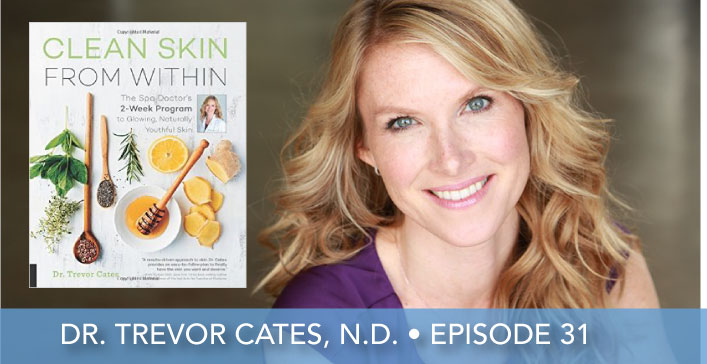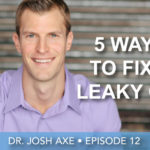Episode 31 | Dr. Trevor Cates, N.D. | Clean Skin From Within

CLICK PLAY!
FAMILIAR WITH PODCASTS? LISTEN ON iTUNES!
Follow Along With The Transcript!
Kathy Smith: Trevor, welcome to the show.
Trevor Cates: Thank you, Kathy. It’s so great to be here with you.
Kathy Smith: Yeah, I loved seeing you on Good Day L.A. and I love that your back in Park City and might be skiing this weekend. So, it’s kind of nice to have that quick little flight so you can get back to the outdoors right away.
Trevor Cates: Yeah. That’s one of the great things about living in Park City, for sure.
Kathy Smith: In your book, you start with stepping inside the body and tackling what you call the six root causes that lead to imperfect skin. So, can you delve into it a little bit. What are some of these underlying factors?
Trevor Cates: Yeah, absolutely. In the book Clean Skin from Within, I talk about the six root causes that I’ve connected with skin issues. Now, I’ve been doing research over the years. I’ve been figuring this out with my patients, with my own personal health issues and I share it in the book. But let’s talk about a few of these.
I think one of the big ones that we want to talk about is having to do with our gut health. Because so much of our gut microbiome or the microorganisms that live in and protect our digestive system also impacts our skin. And our skin microbiome–because our skin has its own little delicate balance – actually big delicate balance – of microorganisms that live on a protective skin exteriorly. So, there’s this big connection between the two, and so many of the daily choices that we make, and our lifestyle, impact this, either positive or negative.
Kathy Smith: When you talk about gut health, I mean, I would imagine it starts with what’s on your plate, and it’s one of the things you talk about in your book about having a clean plate. Give me a day in the life of Trevor or the day in the life of someone who’s conscious about their skin, their body. What should we be eating so we have radiant skin?
Trevor Cates: Like you said, so much of the gut health is related to our diet, especially when things have gotten off balance from our lifestyle choices from dietary choices we’ve made, being overly stressed, taking certain medications like antibiotics can throw that off. These kinds of things can disrupt the balance of our gut, but when we focus, we go back to a healthy lifestyle, we go back to our diet, we can restore that. So, not all is lost. We can get it back, because we all have those moments when we’ve been stressed, we haven’t made perfect lifestyle choices.
Certainly, getting back on track is what I’m all about. It’s really important when we’re talking about gut health. There’s certain things that are particularly important.
One is getting plenty of fiber in the diet. Getting a lot of the high fiber foods is those fresh fruits and vegetables. Eating those kinds of things are going to actually help with the prebiotics, helping feed the good bacteria in our gut and, then, also helping those continue to grow those probiotics and lactobacillus and those kinds of good microorganisms by eating foods rich in probiotics like fermented vegetables or coconut yogurt. Those are the kind of things that when we eat those, those are going to help our gut health.
It may not be a surprise to people to include these things, but the more you can do to incorporate these and cut out the sugary foods, the processed foods. A lot of times I think when people think about eating healthy, it’s for weight loss or achieving their ideal weight. Of course, that is a part of the reason why we eat healthy, but there’s so much more about healthy eating than just weight, and it really shows up on our skin.
I can’t begin to tell you over the years how I’ve seen this happen over and over again when people clean up their diet, when they start making these healthier choices, how their skin can clear up. I’ve seen it with acne patients with their skin clearing up, having less break outs on their face, chest, back areas.
Also, people with eczema, people of all ages with eczema, even children with eczema. Then, also, things like psoriasis. Also, working in the spa, a big part of what people are asking about is the aging skin because we’re all getting older. None of us are getting younger. But what we do with these day to day lifestyle choices in eating these healthy foods is going to help us age more gracefully.
Kathy Smith: Yeah, we all want that. And speaking of that, the aging skin. That’s my category. I know that I love oil and moisture on my skin, but one of the things you talk about is the oils we put in our body. I remember years ago, and I don’t know if you remember when Dr. Perricone had a special out, a PBS special. One of his big things was salmon, and everybody went on a salmon kind of craze of eating a lot of salmon. In general, what oils and how important is oil on the diet for dry skin?
Trevor Cates: I think it’s so great that you bring that up, because the days of the low fat diet are over and we know that they’re–it’s a matter of getting the right fats and the right oils in our diet. So, getting things like avocados and olives or the oils that come from those are fantastic. The monounsaturated fats in those foods are fantastic. I do think that wild Alaskan salmon is a great choice.
I do recommend wild salmon over farm, because you’re going to get more of the benefits and less of the concerns about environmental toxins in wild salmon. You get the Omega 3s that are anti-inflammatory. So many skin issues, one of the big root causes is inflammation, internal inflammation that shows up on the skin. So, when you’re eating the right kinds of fats, it’s going to be more anti-inflammatory. It’s going to help address that root cause.
Then, another thing about salmon, since you brought that up, is that it contains a really potent antioxidant called astaxanthin. It’s one of the things that gives it that pink color. Certainly, wild salmon has more of that pink color than farm salmon. So, astaxanthin helps protect our skin from the inside out. It helps protect against oxidative damage and the free radical damage that really speeds up the aging process.
Kathy Smith: I noticed when you were on TV yesterday that you had a great salmon recipe that you wrapped in kale. You combined something with salmon. What was it again?
Trevor Cates: Oh my gosh! It’s one of my very favorites in the book. The funny thing with host, he couldn’t put it down. He kept munching on it the whole time during the segment. It was really funny. And afterwards, after we even cut.
It’s pretty simple actually, but when people think of salmon, they’re thinking mayonnaise and creamy things and stuff. So, it’s really fresh and light. It’s beautiful. You could take a piece of cooked salmon that you have maybe left over from another recipe. I talk about these things in the book, about how to repurpose recipes, make extra and, then, use a little leftovers or you can get canned salmon. Again, I always prefer people to get wild salmon and, then, mixing it with some sliced cucumbers and red onion and some lemon juice and herbs and a little olive oil. Then, you mix it up in there and, then, you wrap it in collard green. You get a fresh collard green uncooked. Get a nice big one, big leaf. You can get it a little damp to make it soft or coat a little bit of oil on it just to soften it a little bit. Then, you put about half a cup, however big the leaf is. You put that inside the leaf and, then, kind of roll it up like a burrito. It is fantastic. It’s tasty. It’s crisp, delicious. I love making it for lunch in particular.
Kathy Smith: I loved it. It looked so good. I’m going to make it this weekend. But let me ask you something. Because there’s a doctor in the house–I have my own personal doctor here right now. I need a little personal help. Let’s flip back to gut health for a second, because let’s say you’re following the rules. Let’s say sugars, drinking, you’re eating the right things, but I actually ended up getting a little stomach something last week and my gut is off.
Now, I think everybody’s gut sometimes gets off, and off can mean a lot of different things. It can be a little bit more gassy, more bloaty, a little bit like ah, I put something in and it doesn’t feel right. So, I know the rules just like I know the rules of exercise and whatever, but if you could just say, ok, we know Kathy’s got most of rules, right? What would you say to Kathy to say, like, “Ok, you need to get your gut back in order. Here are the one, two, three, four, five things that I would do in the next four days to just make sure that you get it back on track.”
Trevor Cates: Well, Kathy, I know you live a healthy lifestyle so I know you’re doing a lot of the things like I mentioned – eating the fiber rich foods and probiotic rich foods. So, in addition to doing those things and cutting out sugar and processed foods, getting the right kinds of fats, I would say that getting a high-quality probiotic might be one of the things to help you get your gut health back on track.
We have this delicate balance of microorganisms in our digestive tract. Sometimes we eat the wrong foods. If we’re exposed to some bacteria, some parasites, different things–believe it or not, we’re exposed to a lot of these things on a regular basis. Many of us, our body fights it off and creates the balance, but it’s always good to help give it a little extra support, especially if you start to notice some of the things that you mentioned – the bloating and kind of feeling more a little bit of gassiness and those sorts of things. Taking a high-quality probiotic can be fantastic.
Now, for someone who has more long-term gut issues, it might be a matter of trying to get some testing done, going to see a functional medical doctor and have some testing done to see what kinds of dysbiosis issues and imbalances in the gut are going on so you can specifically address those. If there’s an overgrowth of harmful bacteria, which can sometimes happen, there are herbs that you can take to help balance those out, to kill those off and help support the good bacteria instead. So, then, really zoning on and figuring out what that is is going to be particularly helpful.
Also, there’s something called a leaky gut where our gut can become more permeable than it should, and that can lead to allergies, sensitivities. Those kinds of things can happen and more internal inflammation as a result of all that. If that seems to be going on, if you feel like that might be a contributing factor for you, Kathy, then doing things like taking L-glutamine as a supplement could be helpful. Again, probiotics are great for that. Then, there are some great mucilaginous herbs like aloe and slippery elm and those kinds of things that can help really heal the gut from the inside out.
Kathy Smith: Oh, my gosh. You’re great. I hope the audience benefitted from that, because I think we all get to a point at times in our life when this happens. I like the thing about the slipper elm, the aloe you mentioned. That’s what it feels like – needing something healing, and who knows why we get to a point?
Maybe it’s what we’re going to get into next that I want to talk about, which is I know you’re a advocate of what you put on your skin. So, tell me, why is it so important about what we put on our skin, whether it’s our body or our face?
Trevor Cates: Kathy, it’s crazy the amount of products that we’re using on a day to day basis and the amount of toxins that we’re exposed to in this way. On average, we use nine personal care products a day, and that exposes us to 126 unique ingredients. The thing is, though, is in other countries, like in Europe, they’ve banned over 1,000 ingredients in personal care products. But in the United States, the FDA has only banned 11 ingredients in our personal care products.
Kathy Smith: Crazy, crazy.
Trevor Cates: It’s so crazy, isn’t it? It leaves it up to us to do our own detective work, to read labels and hopefully find products that are going to be cleaner and healthier for us. Because the thing is, our skin is our largest organ. It is an organ of the body. It’s permeable. What we put on our skin can get absorbed.
That’s one of the reasons people use hormone creams and nicotine patches, those sorts of things. You put them on your skin because they can get absorbed. There are ingredients in personal care products and skin care products that are designed to permeate the skin so that it can make your skin feel softer, but they can end up in your blood stream.
Some of these ingredients have hormone disrupting affects. There’s a group of chemicals called endocrine disrupting chemicals. They are known to have hormone disrupting affects in the body and have been linked to things like thyroid disease, obesity, certain types of cancer like breast cancer and prostate cancer, infertility, a number of different issues.
We’re exposed to endocrine disrupting chemicals in our air, water, food and also our personal care products. And we’re exposed to these chemicals more now than we ever have, because there are new products being developed, more chemicals being developed now, but we also have all the chemicals that have been made throughout time and that continue to exist in our environment. They continue to exist in our soil, in our water. They’re still made in other countries where they actually travel over in clouds and, then, rain down into our environment. So, unfortunately, that’s the bad news.
The good news is that we do have control over certain things in our environment. We have control over the foods that we eat, the air and things that we have in our home. We also have control over our personal care products. So, those are the places where I have my patients start, and that’s what I talk about in the book. I talk about how to have–we’ve talked about food already. I talked about the clean plate part, which is the foods to eat. I talk about clean slate. The products that you put on your skin and making sure that they’re free of the most common toxins and instead have the healthier, natural ingredients. I also talk about a clean body, about how to reduce toxins in your air, water and food. And just to add this on there right now, I also talk about a clean mind, because stress is a toxin too.
Going back to personal care products, we want to be careful with what we’re putting on our skin. I do talk about 20 ingredients to avoid. In my book, I share a lot of research. I did so much research on personal care products, on food, on diets, on treatments for skin. So, I’ve included all of that.
Kathy Smith: Yeah, I know. I really love the way you laid it out, because it is. You’ve got so much packed in the book, but it’s also easy to access. So, not only is it a good read, but it’s also a good resource. I was looking through the list of 20 things to avoid in your skin care products, and there’s one line I love in there. You go, “Would you slather gasoline or diesel fuel on your face? How about plastic or formaldehyde or tar?” Of course not, but a lot of these are on your popular skin care products. So, when you read it like that, you’re going, “Oh, wow! Maybe I should listen up. It’s pretty shocking, some of the ingredients.
Trevor Cates: Right. Isn’t it amazing? People might be thinking, “How is that possible that I’m putting that on my face?” But those things actually are in personal care products, and people use them every day. It’s insane what we use on our skin without really thinking about the fact that it’s going to be absorbed through the skin, and my feeling is that if you really can’t put it in your mouth, then you probably shouldn’t be putting it on your skin.
Kathy Smith: Yeah, and I like it. Even the book where you have some of your recipes for masks – avocado masks and whatever and you say, “Take a bite of it if you want, because it’s also good for you.”
But you know what’s interesting about this hormone disrupters? The part that I think a lot of people haven’t made the association, a lot of women, is with home products. I will tell you I can walk into a home and when somebody’s using Bounce and products that have a lot of fragrances in them, my body just reacts to it immediately. I don’t know if other people don’t react to it or they just don’t notice the reaction. But if I use Bounce on my clothes, if I put a fabric softener–for people who don’t know, Bounce is a fabric softener. But if I use something like that or when I have, I will start to feel an irritation on my skin, and I will start to feel a little bit of a rash. I’ll start to notice a little bit of a rash. What do you have to tell us, and what are your suggestions about home products?
Trevor Cates: That’s a really good point that you bring up, because for you, Kathy, I think it’s a combination of things. I feel like we’re having a consult here.
Kathy Smith: Do I owe you for this? How much?
Trevor Cates: Of course not. A lot of times, it’s a combination of things. It can be somewhat genetic. So, you might have a genetic predisposition to not be able to handle these chemicals very well, so your detoxification, your Methylation pathways in your body, those may not be working as well as maybe somebody else that has different genes. That doesn’t mean that it’s all [unclear 00:20:55]–it’s ok. It’s just that you’re going to need to be a little bit more proactive in protecting yourself against these things and doing a little extra lever support. Certainly, that is quite common for people to have these genetic variances. We can change our genetic expression by the lifestyle choices that we make.
So, it’s really great that you’re aware of these things. Then, I think because you’re aware, you notice things that maybe other people don’t notice. I can’t begin to tell you how many times when people do my two-week program, they’ll say to me, “You know what? I never even had any idea how much I was sensitive to these things and didn’t know it.” But when you take them out of your environment, when you take the foods out of your diet or like so many of the things that you’re talking about with fragrances, you take them out and, then, if you get exposed to them again, you realize how much better you feel without them.
Kathy Smith: Um-hmm. I totally agree. What do you think about exercise, my favorite subject? I know that exercise is a detoxifier, and I know that it’s useful for so many aspects of your body, including as you mentioned, the weight loss and mental clarity and everything that I always talk about from bone density down the line.
But when it comes to skin, there is a purification process. I do notice that some women have this discussion about to sweat or not to sweat and how that impacts your skin, so can you maybe talk topline about exercise but also getting down to the very practical – you’re going to the gym and are my pores going to clog or am I going to have bacteria on my face, and what are some of the practical things we should know about exercise and skin care?
Trevor Cates: Absolutely. Ok, so, the thing with exercise is one of the great things is–and maybe you’ve already talked about this on the show, but because one of the reasons it’s such a great detoxifier is that we carry around a lot of toxins in our fat cells. That’s where a lot of toxins are stored, a lot of those chemicals that are in your skin care products. If your body doesn’t release them, many of them get stored up in your fat cells. So, when you exercise or any time you’re sweating–so if it’s a sauna or exercise, when you’re sweating, it causes lipolysis, the breaking down of the fat cells. So, then, you release those toxins out of the fat cells, which is a great way to release those chemicals out of the body. Then, you just want to make sure you’re drinking plenty of water and your kidneys and your liver is working well and, then, your body does the rest for you.
So, it’s a great thing to do as part of daily detoxification as well as if you want to really ramp it up. So, that’s one of the reasons why exercise is great for your skin from more of a detoxification standpoint.
Also, it helps with the blood circulation lymph flow of your body. So, I think everybody’s probably noticed that they get a healthier glow and a glisten and glow when they exercise. So, that’s another reason why it’s great for the skin. It gives you that beautiful glow. It helps with the circulation which is going to help nourish your skin cells so that they can do their job at turning over and being healthy.
One of the things, though, to think about when you’re exercising is the products that you have on your skin, on your face in particular, when you’re working out. It’s a good idea to go to–when you go exercise and you know you’re going to be sweating, to not wear makeup. I know sometimes it’s a vanity issue and you want to look good, but I want to encourage you to really at least not wear the foundations, the cover ups, the stuff on your skin. Wear little bit of mascara, a little eye liner and a little lip gloss if you want to look good while you’re working out, but try not to wear anything that’s going to clog your pores.
One of the big ingredients to be careful of, because this is one of the ingredients that’s in many moisturizers is dimethicone. It’s d as in dog, i, m, e, t, h, i, c, o, n, e. This is in many skin care products and moisturizers. What it does is it traps in the moisture under that layer of moisturizer so that your skin is not able to kind of breathe and to circulate and have the air flow. What will happen is you’ll probably end up more flushed, especially if you tend work out and you get the red face. Make sure you’re not wearing this product because it’s also going to disrupt your skin microbiome. The bacteria may overgrow and cause you to break out.
Kathy Smith: Good call. What about after working out? Any recommendations especially for those women that are more prone to outbreaks? I’m not in that category, but I notice one of the things in your book and I love the way you did it was talking about the five different types of skin. You gave each type of skin a face. There’s a face to the skin, because there was a person who was either a client or–that had that type of skin. I know that I don’t have to be as cautious about what I do afterwards, but my daughters have to be very cautious or they get breakouts.
Trevor Cates: Yeah. I think it’s generally a good idea for us to all be in the practice of cleansing our face after we work out. I think it’s a great way to clear off the debris on your face, the perspiration and using a good cleanser.
Now, here’s the thing though is that many of the cleansers out there are stripping, for the skin. They remove beneficial oils. They’re disrupting the delicate PH of the skin. That’s why I created my own skin care line so that people can have the good products and that they’re clean and that they’re well PH balanced and natural actives. Using a good cleanser such as the one that we have in the Spa Dr. line is a great thing to do after working out, because it’s going to help remove the impurities and, then, also restore your skin back to the PH that it needs.
Kathy Smith: Yeah, it’s interesting. It’s not discussed that much, but I do believe that stripping the skin, especially as you age, just adds to the aging process. All those wonderful oils that make us look youthful, we’re taking off or stripping every single day. I like the fact that you addressed that in the book and, then, you actually have a product that also addresses it.
Let’s take it one step further. When we get to skin care–and maybe we can get into your skin care line a little bit here, but when we get to skin care, one of the things that’s a buzz word on every television ad and every magazine you open up is about exfoliation and getting rid of dead cells. So, how much exfoliation is good, and can you push it too far and exfoliate a little too much?
Trevor Cates: Yeah, it’s a great question. I think there is definitely a tendency for us to over exfoliate. I think there’s a little bit of a good thing and, then, people think, “Oh, if I do more of this, then it will be even better.” Some exfoliation is good, but it’s important to do a light exfoliation and not do stuff that’s really abrasive, because when you’re doing really abrasive exfoliation, it can actually damage the collagen in your skin and cause it to break down more rapidly. So, then, that will speed up the aging process.
So, you want to be careful with exfoliation. I think exfoliation is good. I think using some enzymatic exfoliation–like, that’s why in my book, I give do-it-yourself skin care recipes for, like, a papaya exfoliation, which has papain, which is an enzyme that helps break down the dead skin cells off the face. So, things like that can be helpful.
Then, also, some mild exfoliation is–in my do-it-yourself skin care, I talk about some mild exfoliation, so more like oat flower and those kinds of things rather than–I see some people using things like coffee grounds and really harsh, scratchy kind of things on their face. I wanted to encourage people to move away from those and have more of the gentle exfoliation.
Kathy Smith: Ok. I could talk to you forever, but we’ve got to wrap up now. So, if there was a wonderful mask that you could leave us with that somebody wants to sit back, do a little meditation, do a little deep breathing, and they want to put a mask that’s going to brighten up their skin, and they’re going to their kitchen, what could we put on our skin to moisturize and just calm and soothe?
Trevor Cates: Well, there’s so many great ones. Since I just mentioned papaya, I’ll just tell you about the papaya face mask because it’s both exfoliation and hydrating and nourishing. You can use an equal amount of papaya. You just get fresh papaya flesh, scoop some of that out. Like, a tablespoon of that and, then, a tablespoon of yogurt – plain, unsweetened yogurt. You could use Greek yogurt or goat yogurt, whatever kind of yogurt you want to use, just a tablespoon of that and, then, also a tablespoon of oat flour. This is a recipe that’s in my book. You blend all that up and, then, apply it to the face. Leave it on for, like, 10 minutes.
Now, if you tend to have very sensitive skin, you might want to rinse it off more quickly, because the papaya can start eating away at the dead skin cells. For some people, they start to feel that tingly feeling and, then, you can just rinse it off earlier. But it’s a great mask because the yogurt helps feed your skin with those probiotics, very nourishing hydrating skin. Oats are really fantastic for the skin and hydrating the skin and being nourishing, and like I said, the papaya helps remove the dead skin cells.
Kathy Smith: Ok. I’m going to have to go buy my papaya now, which also helps my gut, right? Those enzymes will be good. I can also eat it.
So, I would say that the biggest take away for your book is that it’s all about quality, both quality of what goes inside your body with the food that you eat and, then, what you put on your body and you put on your face.
It’s so true that clean skin starts from within. Everything from gut health to detoxification systems to hormonal balance to stress levels, all affect what happens on the surface of your skin. So, if you want to learn more, then you’ve got to pick up Trevor’s new book. Once again, it’s called Clean Skin from Within, and it’s a must read.
Also, I would recommend that you take her skin care quiz, which is at her website, which is DrTrevorCates.com. We’ll have the spelling in the liner notes here. You’re going to learn so much about your skin by taking this quiz, so go for it. And, of course, don’t forget to check out her podcast, The Spa Dr.
So, Trevor, it was great having you, and I’ll see you on the slopes.









